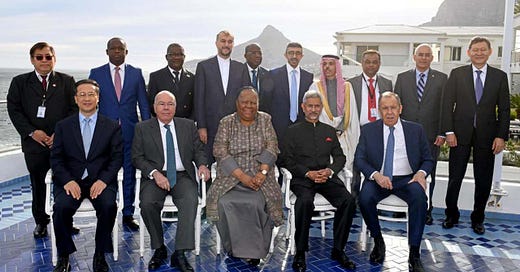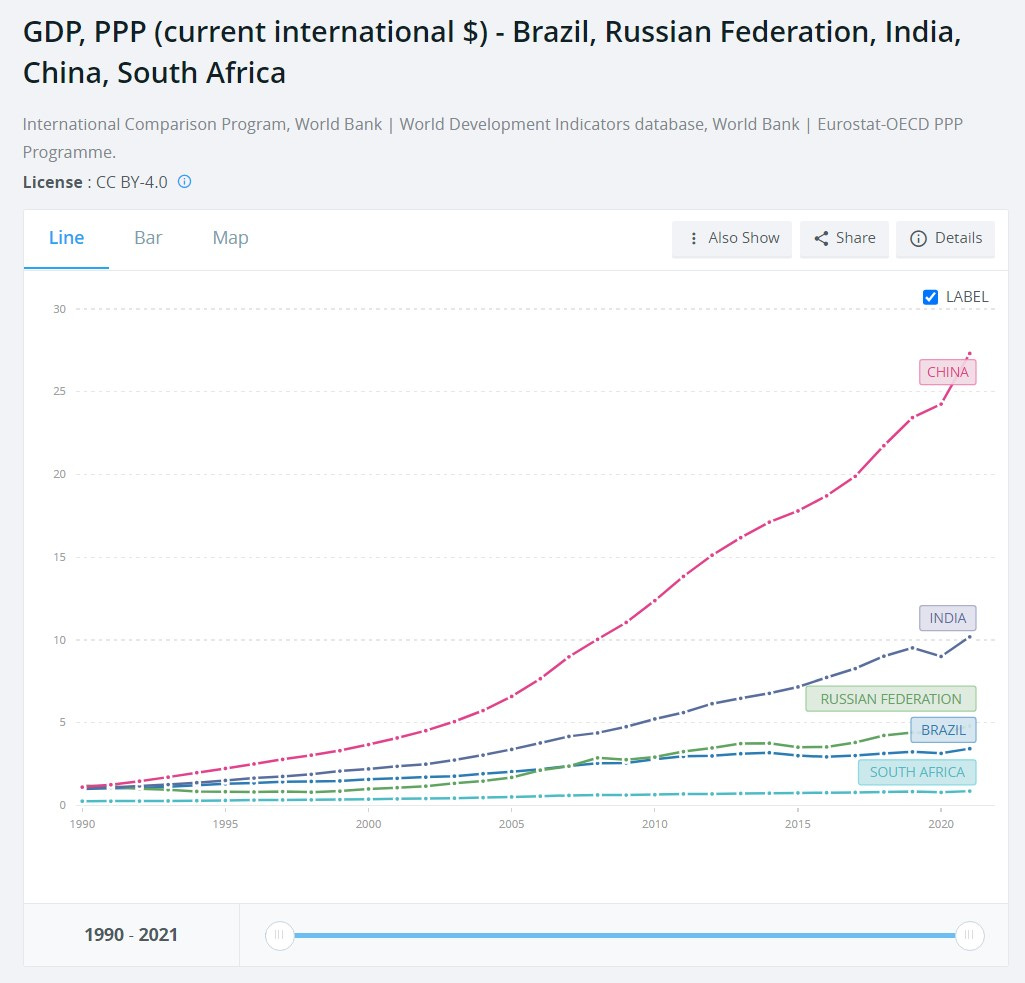BRICS bloc is adding members, planning new currency to challenge US dollar
Foreign ministers from BRICS (Brazil, Russia, India, China, and South Africa) met to discuss expanding the Global South-led bloc and creating a new global reserve currency to challenge the US dollar.

The BRICS bloc of Brazil, Russia, India, China, and South Africa is expanding, as its members grow in economic and political influence.
Together, the five BRICS members represent more than 40% of the global population, and their share of the world economy (when measured in purchasing power parity) is larger than that of the G7.
The foreign ministers of the BRICS states met in South Africa on June 1 and 2. There, they discussed a series of issues, including plans to create a new global reserve currency to challenge the dominance of the US dollar.
Also present at the meeting in South Africa was a group of top diplomats from countries described as "friends of BRICS", including Egypt, Iran, Kazakhstan, Saudi Arabia, and the United Arab Emirates.
More than 20 countries have expressed interest in joining BRICS. At least 13 nations have formally applied.
South Africa's ambassador to BRICS commented, "We are getting applications to join every day".
Prospective future members include Algeria, Argentina, Bahrain, Belarus, Egypt, Indonesia, Iran, Nigeria, Saudi Arabia, Türkiye, and the UAE.
In a summit of South American leaders in Brazil in May, President Lula da Silva revealed that he also supports Venezuela joining BRICS.
At the June foreign ministers meeting, Bloomberg reported, "BRICS nations asked the bloc’s specially created bank to provide guidance on a how a potential new shared currency might work, including how it could shield other member countries from the impact of sanctions such as those imposed on Russia".
"The use of alternative currencies was among the prominent talking points" at the meeting, Bloomberg noted.
South Africa's foreign minister, Naledi Pandor, explained at a press conference that BRICS members want to “ensure that we do not become victims to sanctions that have secondary effects on countries that have no involvement in issues that have led to those unilateral sanctions”.
Reuters acknowledged that the BRICS "ministers sought to focus attention on their ambition to build up their influence in a multi-polar world".
India's Foreign Minister S. Jaishankar, Reuters wrote, "spoke of the concentration of economic power which he said 'leaves too many nations at the mercy of too few', and of the need to reform global decision-making including by the United Nations Security Council".
China's Vice Minister Ma Zhaoxu welcomed the idea of expanding BRICS. In a clear criticism aimed at the Western-dominated G7, he said that BRICS "was inclusive ... in sharp contrast to some countries' small circle, and so I believe the enlargement of BRICS will be beneficial to the BRICS countries".
Today, BRICS members make up roughly one-third of global GDP, when measured with purchasing power parity (PPP), and their economic weight is steadily growing.
The share of the world economy represented by the G7 bloc of the United States, Canada, Britain, France, Germany, Italy, and Japan, on the other hand, has been gradually decreasing.
In 1995, the G7 economies made up roughly 45% of global GDP (PPP), with the BRICS nations at around 16%. As of October 2022, the BRICS economies represented 31.5% of the world's economy, against just 30.7% for the G7.
China accounts for the majority of the BRICS' substantial economic weight.
According to World Bank data, the BRICS bloc had a combined GDP (PPP) of $46.62 trillion as of 2021.
China made up 59% ($27.31 trillion) of the total BRICS economy, compared to 22% ($10.19 trillion) for India, 10% ($4.81 trillion) for Russia, 7% ($3.44 trillion) for Brazil, and 2% ($868.58 billion) for South Africa.
However, the large share of the BRICS economy represented by China and to a lesser extent India is partially a reflection of their massive populations, with more than 1.4 billion people in each country, compared to 219 million in Brazil, 142 million in Russia, and 58 million in South Africa.
When GDP (PPP) is measured per capita, Russia has the highest level in the BRICS, at roughly $33,000 as of 2021, following by China at $19,338, Brazil at $16,031, South Africa at $14,624, and India at $7,242.
Beijing's newspaper China Daily stressed how the rise of the BRICS is a significant "challenge to US dollar dominance".
"In an economic development that hasn't received much attention in the Western media, the GDP of the BRICS nations has surpassed that of the G7. That news, coupled with plans by the BRICS (Brazil, Russia, India, China and South Africa) nations to create their own currency later this year presents a challenge to the US dollar as the world's primary reserve currency", China Daily wrote in April.
The heads of state of BRICS members plan on meeting at a summit in August in South Africa.
There are, however, reports that Pretoria may ask another country to host the meeting, because Western countries are pressuring South African officials to arrest Russian President Vladimir Putin.









The global majority is starting to get organized. Western elites may start to suffer from cold sweats and shivers down their spine. No more easy wealth extraction via debt colonization and crony Neoliberal Shock Doctrine.
Tragically, the petulant West is waging war and scapegoating its own failures when it should be building back better, and showing contrition and reciprocity with the rest of of the world. The multipolar world is not an option it is an existential essential for planet Earth. Wars and chaos are no longer affordable sound and sane global leadership must prevail.